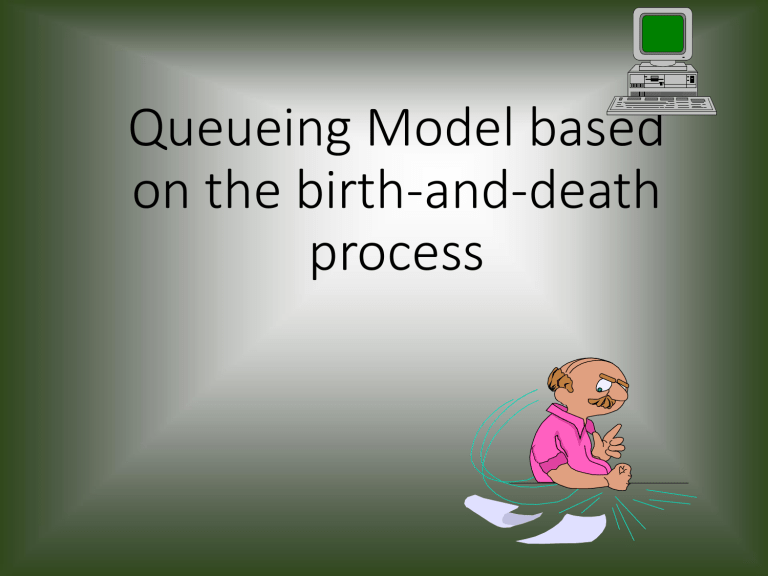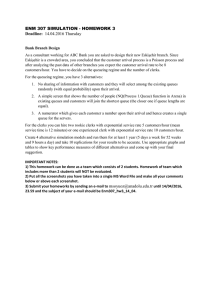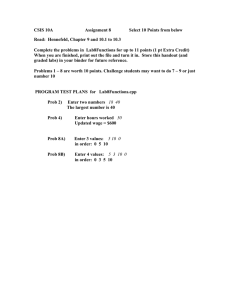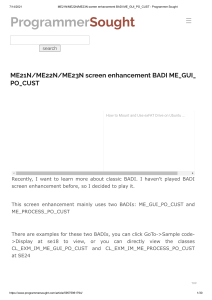
Queueing Model based on the birth-and-death process M/M/1 •an infinite number of customers •Infinite queue •Inputs and outputs are at a constant rate •There is only one server M/M/1 system • For M/M/1 the probability of exactly n customers arriving during an interval of length t is given by the Poisson law. Poisson’s Law ( l t) - l t Pn (t ) = e n! n (1) l- Rate parameter • =event per unit interval (time l distance volume...) The M/M/1 queue in equilibrium queue server State of the system: • There are 4 people in the system. • 3 in the queue. • 1 in the server. Memory of M/M/1: • The amount of time the person in the server has already spent being served is independent of the probability of the remaining service time. Memoryless • M/M/1 queues are memoryless (a popular item with queueing theorists, and a feature unique to exponential pdfs). . P k = equilibrium prob that there are k in system Birth-death system • In a birth-death system once serviced a customer moves to the next state. • This is like a nondeterminis-tic finite-state machine. State-transition Diagram (Rate diagram) • The following state-transition diagram is called a Markov chain model. • Directed branches represent transitions between the states. • Exponential pdf parameters appear on the branch label. Single-server queueing system lPo 2 1 0 P1 l P k -1 l P1 P 2 ... lP k k k-1 P k k+1 P k +1 State diagram: single-server model λ # in system 0 λ ● 2 1 μ λ μ 3 μ # in system also called state. ●To get from one state to another, an arrival (λ) must occur or a service completion (μ) must occur. ● In long-run, for each state: Rate in = Rate out Mean # λ = Mean # μ Waiting Lines 13 Symbles: l = mean arrival rate (cust. /sec) l P0= mean number of transitions/ sec from state 0 to 1 = mean service rate (cust./sec) P1 = mean number of transitions/ sec from state 1 to 0 States • State 0 = system empty • State 1 = cust. in server • State 2 = cust in server, 1 cust in queue etc... Probalility of Given State • Prob. of a given state is invariant if system is in equilibrium. • The prob. of k cust’s in system is constant. Similar to AC • This is like AC current entering a node • is called detailed balancing • the number leaving a node must equal the number entering Balance equations for each state State 0 Rate in μP1 = Rate out λP0 Probability in state 1 The only way into state 0 is service completion from 1 Probability in state 0 The only way out of state 0 is to have an arrival Waiting Lines 18 Balance equations for each state (cont.) State 1 Rate in λP0 + μP2 = = Can arrive state 1 by arrival from 0 or service completion from 2 2 3 λP1 + μP3 λP2 + μP4 Rate out λP1 + μP1 Two ways out of state 1, arrival or service completion = λP2 + μP2 = λP3 + μP3 etc. 19 Derivation State 0: l P 0 = P 1 lP0 P1 = Derivation lP0 l P2 = State 1 2 l P0 P2 = 2 since l P k = P k+1 then: k 6 l P0 k P k = k = P0 l where = = traffic intensity < 1 since all prob. sum to one k=0 k P0 = 1 = P0 k =1 k =0 Note: the sum of a geometric series is 1 = 1- k=0 k k k=0 1 = 1- • Suppose that it is right, cross multiply and simplify: k=0 k=0 k k =1 So Q.E.D. k=0 k - = = 1 k =1 k 0 subst 7 into 6a 6a P0 k =1 k =0 7a P0 =1 1- 7b P0 = 1- and =prob server is empty subst into 6 k l P0 k P k = k = P0 yields: 8 P k = (1 - ) k Thanking You…!!




